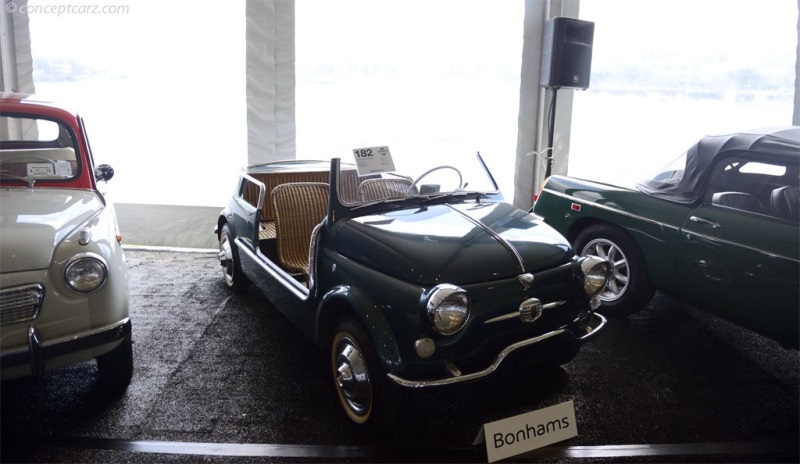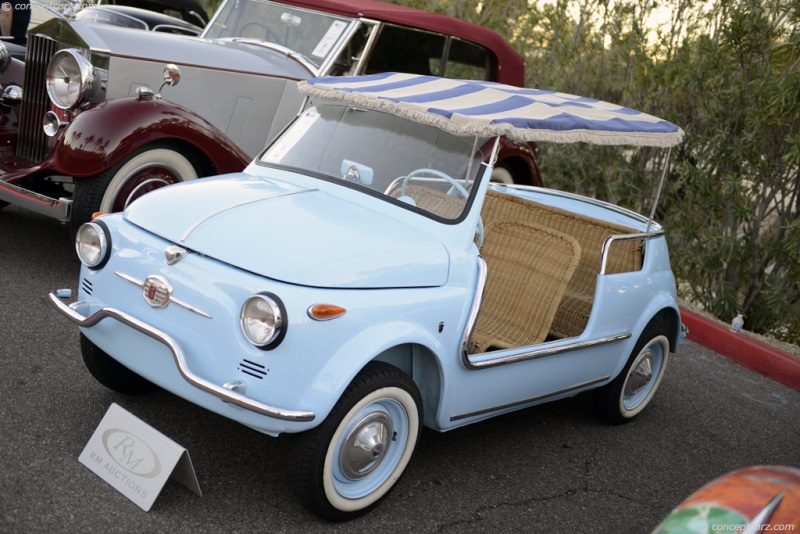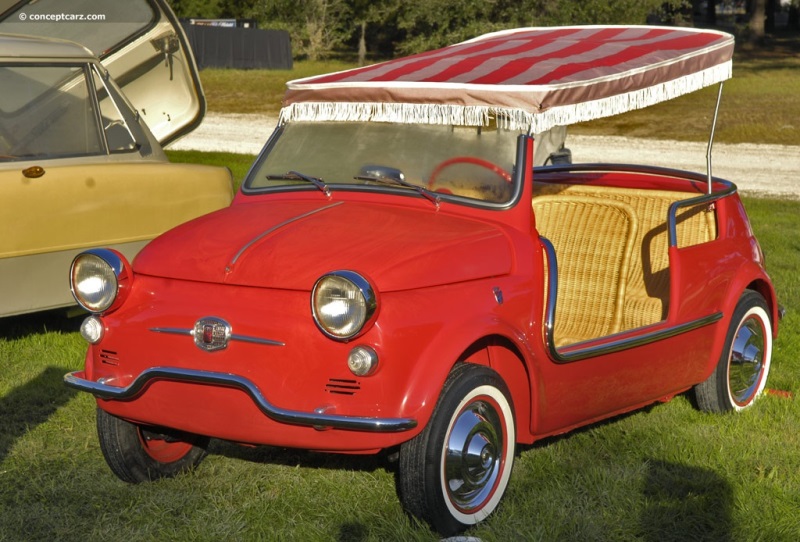


Coachwork: Ghia

 Sold for $110,000 at 2014 RM Auctions - Automobiles of Arizona.
Sold for $110,000 at 2014 RM Auctions - Automobiles of Arizona.The Fiat Jolly was based upon the mechanicals of the Fiat 500 (the 'people's car'). The Jolly had dune buggy-like bodywork by Ghia of Turin, with open sides, a surrey top, and wicker seats. They were often finished in shiny colors.This example has been treated to a meticulous body-off restoration finished in the factory color of Celeste Medio paint. The engine is a 479cc overhead-valve twin-cylinder unit offering 16.5 horsepower. There is a four-speed manual transmission and four-wheel hydraulic drum brakes.
By Daniel Vaughan | Feb 2014



Coachwork: Ghia
Chassis #: 110 031297
Engine #: 110 000 0033949
Sold for $53,900 at 2017 Bonhams : Greenwich Concours.
Prior to entering the current owner's care about seven years ago, this Jolly was in the care of an owner for approximately 10 years in Syracuse, New York and during that period had received an engine rebuild and a new canvas top. It is believed that the Jolly had been used at the 1964 World's Fair to transport elderly or disabled persons. In 2015, the current owner installed a new and complete Fiat 500 650cc Sport Engine and clutch assembly. The brakes were overhauled to handle the additional horsepower by the new engine. The parts that were removed from the car have all been kept with the vehicle.This example is finished in deep blue-green metallic paint and dark wicker seats.
By Daniel Vaughan | Jun 2017
The Fiat 500 was introduced in 1957 as a successor to the Topolino model. (Topolino means 'mouse'). The designer was named Dante Giacosa, an individual who would later become an automotive legend for his contributions to the industry. The 500 was a two-seater, rear-engine, utility car that was built as an economical means of transportation void of luxury items or sports-car intentions. It featured a 479cc overhead valve engine mated to a four-speed gearbox. With 13 horsepower the 500 never set any land speed records. It had a top speed of 85 km/h. To help improve the performance of the 500, Carlo Abarth offered bolt-on aftermarket parts and accessories. These additions helped with increasing the horsepower and performance of the engine as well as improving the handling and making the vehicles more fun to drive and competitive on the streets.In 1957, the 500 received 2 extra horsepower, bringing the total to 15. Wind-up windows were now standard.
In 1965, the 500F lost its suicide doors in favor of the more popular hinged doors. The horsepower rating was once again improved and now offered 19. The top speed was 95 km/h.From 1969 through 1975, a Lux version was offered. This featured full carpeting and plastic revised dashboards.In 1975 production of the Fiat 500 ceased. 3.6 million examples had been produced during its life span. In 2004, Fiat created a concept car that was similar in design and style to the Fiat 500. It was called the Fiat Trepiuno and featured front-wheel drive.The 500 endured a successful life span due to its economical size, excellent fuel economy, ease to repair, styling, competitive price, and city-friendly driving characteristics. Due to its small size, it was easy to navigate and drive in the small, Italian streets. Thanks to its short wheelbase and length, the vehicle could maneuver easily into cramped parking spaces.
By Daniel Vaughan | Sep 2006
From 1958 through 1960, Fiat offered a Sport version. These Sport versions offered a 21 horsepower engine, and a one-piece roof. The standard 500 version had a fold-back sunroof.
By Daniel Vaughan | Sep 2006
With more than four million produced during its twenty-year production run, the tiny Fiat 500 was something to behold. Easy to spot by its rounded egg-like body, the Fiat 500 filled a need for utilitarian transportation for the Italian masses when it was introduced in 1957. The post-war European market needed an affordable option, and the rear-engined Fiat 500 was just the solution. The rear-engine design was taken from the Volkswagen Beetle and proved popular enough to be adopted by several other carmakers.The designer behind the 500 was Dante Giacosa, who was famed for being one of the greatest designers in Fiat's history who not only dealt with the car design but also had a big hand in the engineering. A cheap and practical town car, the Nuova (new) 500 was debuted in July 1957 and is considered one of the first city cars and lasted until 1960. Giacosa was extremely motivated to construct a car that packed more into a smaller space and he did this by making the engine mount at the rear side. It featured a smaller two-cylinder engine than all newer models and produced just 13 bhp. The Nuova featured a fabric roof that folded entirely back to the rear of the car, similar to the Citroën 2CV. It was one of three models that came with 'suicide doors'. A stylish Sport version of the Nuova came with a special red stripe and more power in the engine. With kart-like handling, the four-seat 500 was powered by an air-cooled 479cc flat twin, which eventually was boosted to 499cc that gave 18 bhp. With a top speed of 55mph, the 500 was an incredibly popular and practical vehicle of choice throughout Europe. Weighing at only 1,100 pounds, the 500 had a wheelbase of 72.4 inches, a length of 116.9 inches, and a height of 52.0 inches. The 500 had a Cx (aerodynamic resistance coefficient) of 0,38, which was quite impressive for the era.
The 500 was offered as the 'Giardiniera' station wagon variant in addition to the two-door coupe in 1960 until 1975. The wagon had the standard engine laid on its side, an additional 10 cm wheelbase that made room for a useable rear seat, larger brakes, and a full-length sunroof. Called the K or Giardiniera, the estate version of the Fiat 500 is the longest-running model. To create a flat loading surface, the engine was laid under the floor of the trunk. The roof stretches all the way to the rear and didn't stop at the driver and front passenger like other models of the time. The K came with 'suicide doors', and unlike other models, it continued to carry these doors into the 1970s. Production moved to Desio in 1966 and the Giardiniera was constructed by Fiat subsidiary Autobianchi. Production of the Giardiniera tallied at 327,000 which later examples featuring Autobianchi rather than Fiat badging.The Fiat 500 F or Berlina was produced from 1965 until 1973 and spans two periods of 500 production, the D and the L. Because of the two production periods, the F model is very easily confused and misidentified. The F sported the same badging as the D from 1965 until 1969, but the two models can be easily told apart by the positioning of their door hinges. The F produced from June 1965 finally featured front-hinged doors while the D has 'suicide doors'. From '69 until '72 the F was sold next to the Lusso models as the less expensive 'base model' version. There wasn't much mechanically different from the F and L, but the main differences lay in the bumpers and the interior. The L had an extra chrome nudge bar, and the inside of the L featured a fresher updated look while the F interior didn't change from the original 1957 design. Introduced in 1968 was the L or Lusso 500 model. It featured a modern interior that included a revamped dashboard and paid special attention to comfort and style for the passenger. The 500 L was produced until 1972. The final version of the 500 was the R or Rinnovata version. The R model sported a larger 594 cc engine that was designed by Abarth with a more practical power rating of 23 bhp and a full synchromesh gearbox. This final model was much more comfortable than the previous version yet was more simply equipped and trimmed than before. The fuel gauge was removed and only the low fuel indicator was left. Several custom models of the 500 were produced, including the 'Jolly' version by Carrozzeria Ghia with inspiration taken from the very exclusive Fiat 600 Jolly. The Jolly came with wicker seats, a chopped-roof, no doors, and usually seen with a canopy roof. Showing that they had a lot of muscle behind their compact frame, seven Fiat 500s contested the first and only Liège-Brescia-Liège Rally in July of 1958. They were beaten by Messerschmitt TG500 and the Berkeley SE492s, but the little Italian cars show their rugged side and proved they were capable of incredible durability. Reputed to be the smallest car to complete a world circumnavigation, a 1969 Fiat 500 traveled 32,000 road kilometers in less than 100 days. In 2005, a 1973 500 took a 16,000 km trip traveling through Russia for a 100-day journey. Its progress was documented by newspaper and television stations worldwide and eventually a book entitled La bizzarra impresa ('The bizarre exploit') was published about the trip. In 2007 this same car became the first Fiat 500 to reach the Sahara dunes was taken around the Mediterranean Sea for over 10,000 kilometers.
Sources:
http://en.wikipedia.org/wiki/Fiat_500
http://www.vihti500.info/history-of-fiat500.php
http://www.fiat500america.com/fiat500-history/
By Jessica Donaldson
The 'D' replaced the original Nuova in 1960. Similar in appearances to the car it replaced, two differences set the models apart: the engine size and the roof. The D came with an uprated 499 cc engine that produced 17 hp as standard and continued to be used until the end of the L in 1973. The roof for the D didn't fold back as far as the Nuova, but it that earlier roof was available as the 'Transformable'. The D also came with 'suicide doors'. Torino Motors assembled the 500D in New Zealand and it was locally dubbed the 'Fiat Bambina'.
The Fiat 500 was produced from 1957 until 1975 and was replaced with the Fiat 126. The 500 R was sold alongside the 126 for two years before the 500 was retired. More than 3.6 million Fiat 500 cars were sold during its lifetime and at the end, the production had been outsourced to a Polish company called FSM. The 126 never reached the same popularity as its predecessor in Italy. In March of 2007, Fiat debuted the all-new 500 model, based on the '04 Fiat Trepiuno concept. Its arrival coincided with fifty years since the original 500. The new 500 is also dubbed the bambino and competes with the Mini Cooper and the Volkswagen Beetle.
http://en.wikipedia.org/wiki/Fiat_500
http://www.vihti500.info/history-of-fiat500.php
http://www.fiat500america.com/fiat500-history/
By Jessica Donaldson
Similar Vehicles
Similarly Sized Vehicles
from 1958
Fiat Monthly Sales Volume
March 2023
138
1958 Fiat Jolly 500 Vehicle Profiles
Recent Vehicle Additions
Performance and Specification Comparison
500 Specification Comparison by Year
Year
Production
Wheelbase
Engine
Prices
72.40 in.
Related Automotive News

Auctions America Continues Successful 2013 Season with its Annual Fall Carlisle Sale
Auctions America rounds out its 2013 auction season in Carlisle, Pennsylvania, October 3-4
Two-day Fall Carlisle sale, held in conjunction with the Carlisle Events Collector Car Swap Meet %26 Corral, features a diverse roster of 300 classics, exot...

Auctions America Readies for Highly Anticipated Spring Carlisle Collector Car Weekend
Auctions America returns to Carlisle, Pennsylvania for its annual Spring Carlisle sale, April 25-26
Two-day sale lifts the gavel on a diverse roster of approximately 300 quality collector cars
Notable highlights include a rare 1959 Chevrolet C...

VICARI AUCTION COMPANY OFFERS RARE '62 & '63 Z06 CORVETTES AT 2013 CRUISIN' NOCONA
In a recent rare find, two classic Chevrolet Corvettes (one 62 and one 63) - stored for decades-are being made available by the Vicari Auction Company. Both vehicles will cross the block during 2013 Cruisin Nocona, a north Texas collector car auction...

Barrett-Jackson Flavors Its January Scottsdale Auction With NASCAR Treats
RACING HERITAGE, HIGH PERFORMANCE ARE RECIPES FOR CAR-COLLECTING FEAST
SPEED™ SET FOR 39 HOURS of LIVE COVERAGE STARTING JAN. 15
The great Henry Ford once said, Auto racing began five minutes after the second car was built.
...

TOPLINE COLLECTORS PLACE SPOTLIGHT on SPEED'S BARRETT-JACKSON BROADCAST FROM SCOTTSDALE
TOPLINE COLLECTORS PLACE SPOTLIGHT on SPEEDS BARRETT-JACKSON BROADCAST FROM SCOTTSDALE
LOST SHELBY DUAL PROTOTYPE, HAGERTY GIVEAWAY %26 SALON COLLECTION HIGHLIGHT 39 HOURS OF LIVE COVERAGE
The 42nd annual Barrett-Jackson Scottsdale (Ar...












